PT-85, or M-1981 Shin'heung
North Korean light amphibious tank
By Massimo Tessitori
|
PT-85 is the common western designation of a light amphibious tank whose North
Korean name is Model 1981 "Shin'heung" (Rise), built in North Korea
for the needs of their army. 500 examples of this tank are thought to be operative
with NK army.
Its chassis is
based on the North Korean
VTT-323 APC, a copy of
the Chinese NORINCO YM 531 (type 63).
The most
interesting characteristic of PT-76 and 85 is their anphibious
capability, and it is thought to have a speed around 10km/h in
water.
At present time,
anyway, such light tanks are made obsolete by modern, strongly armed
ICV as BMP-3: if they have to be very large and with thin armour to
float, why not to use the internal extra space to bear infantry? It's
interesting to note that some sources have started to call such IFV as
'light tanks'.
The PT-85
is thought to be powered by a 6 cylinder inline, water-cooled diesel
engine of 240 hp, to have a road speeds of up
to 60 km/h and a ranges of 500 km. The suspensions use the typical
torsion bars.
The PT-85
esteemed weight is about 20tons. The esteemed
overall measures are: Overall
Length: 7.63 m, Width: 3.10
m, Height: 2.80 m.
It has a classic
crew of 4 men: commander, gunner, loader, driver.
The primary armament is an 85mm gun. Besides, the tank is fitted with
a launcher along the top of the barrel, near the gun mount base, for a 9M14
Malyutka (AT-3 "Sagger") anti-tank guided missile. Besides, there is a 7.62
mm coaxial MG on the right side of the main gun. None of the available photos
show the tank armed with any AA heavy machine gun.
Like the
Soviet PT-76, the North Korean PT-85 is fully amphibious, capable of
maintaining a top speed of 10 km/h across water sources. Tha speeed on
a way us thought to be around 60 km/h.
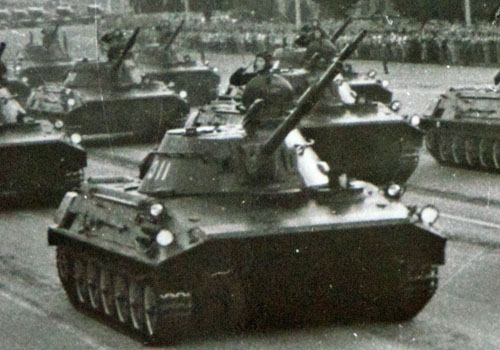 |
 |
Above: photo of an early PT-85 with a
9M14 Malyutka (AT-3 "Sagger") anti-tank guided missile installed
atop the turret.
Note the lack of the IR projector on the turret, introduced on later
production ones, and the lights disposed on the side plates
Above right: a PT-76 image from
http://pl.uzbrojenie.wikia.com/wiki/PT-76.
Right: a scale drawing of PT-76 with measures.
Comparing PT-85 to the PT-76 shown aside, we see that the resemblance
is vague, although the Korean light tank is clearly inspired to
the Russian one that is still in service their army.
PT-85 has an higher turret, horseshoe-shaped, with an 85 mm gun and hatches
similar to those of a T-54.
Not even the hull of PT-85 isn't a direct descendant from that of PT-76,
although wheels and tracks seem identical, and this helps much to esteem
its size.
The hull of PT-85 becomes wider over the fenders,
has sloped sides, driver moved on the right, plates scomposed in different
way etc. |
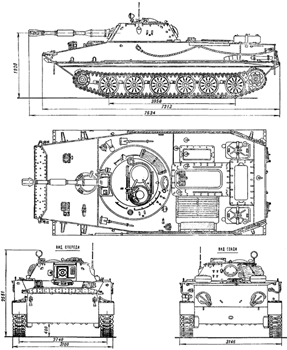 |
 |
 |
Another image of PT-85 aside a Chinese-built YW-531, also known as Type
63.
The hull of PT-85 is clearly a derivative of the Chinese vehicle, but
with deep differences: it is longer,with two road wheels added on
each side, it seems wider too, it has its engine and driving wheel
well on the rear instead of on the front, has idrojets as the PT-76.
|
Image from http://en.wikipedia.org/wiki/Type_63_(armoured_personnel_carrier)
|
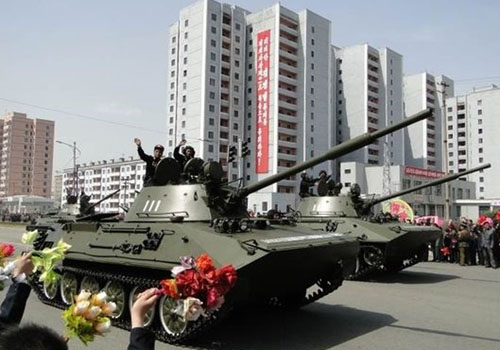 |
Two images of tanks in parade. Details of the right side and of the
rear can clearly be seen.
When compared to earlier examples, these tanks have a large IR projector
on the turret, linked to the gun with a brace for elevation, as on T-55/62;
the arrangement of lights on the hull has changed: now there are three
lights on the right side of the front glacis (two black ones and one white),
plus one on the left side plate; someimes some of these lights are omitted.
Note the absence of the AT-3 missile; it's unclear if this variant can
be armed with that missile, and where could its launcher be installed. |
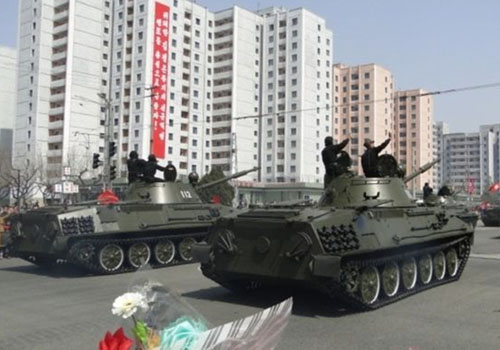 |
An image from the rear, showing the idrojet outlets on the rear
plate, covered by pivoting covers. The idrojet intakes on the hull sides
are only vaguely visible from this perspective due to the incliation of
their grid.
6 spare links are visible on the rear part of the side plate.
Looking at the turret's rear, we see a circular hand grip and a u-shaped
upport plate for something. |
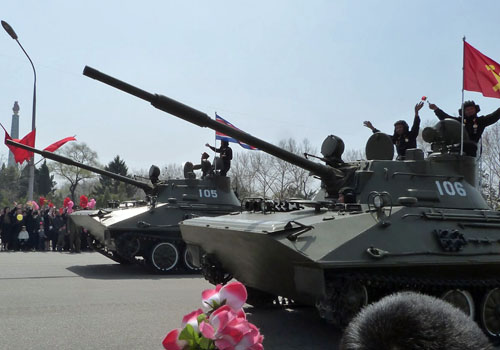 |
A partial image of the left side. This tank looks to have two lights
on the frontal glacis, plus one on the left side plate. |
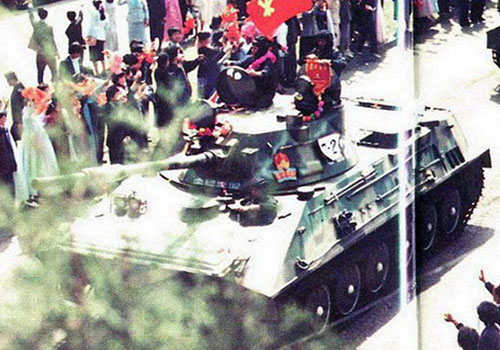 |
Interesting image from above-front.
The tank is camouflaged, apparently with sand bands over the olive green
background.
Although of poor quality, the image allows to see interesting details,
as:
the cylindrical protrusion on the rear-left side of the turret to lodge
the tank commander's cupola, apparently similar to that of T-62;
the arrangement of the tools on the left side of the hull;
interesting markings, perhaps representing a red parachute;
two lights on the frontal glacis, and none on the side plate.
|
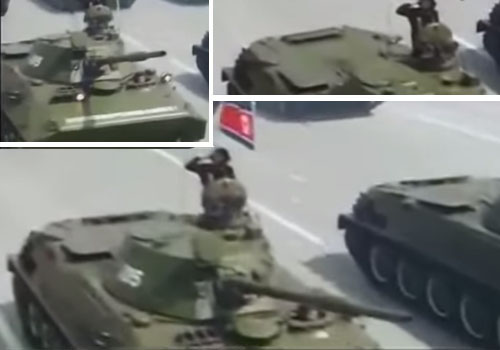 |
Some screenshots of PT-85s from a movie, probably related to the parade
of 2010.
Despite the poor quality of the images, it shows some interesting details:
the shape of the turret, clearly not fully circular, but horseshoe shaped;
only one white light under the guard on the frontal plate, plus one on
the left side plate;
3 track links are located over the light guard;
the inscription is painted on the downed wave shield;
some details of the engine deck are vaguely visible.
http://www.youtube.com/watch?v=zCYjPogXfg8 |
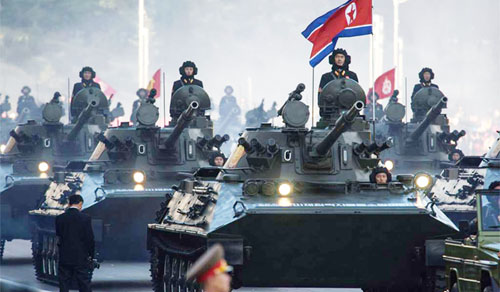 |
A night image of tanks on parade, probably in 2015. The front lights
are definitely 3 on the right side (of which two are IR) and one on the
left side. |










